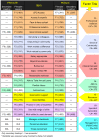Retention of the rural allied health workforce in New South Wales: a comparison of public and private practitioners
- PMID: 23351491
- PMCID: PMC3599445
- DOI: 10.1186/1472-6963-13-32
Retention of the rural allied health workforce in New South Wales: a comparison of public and private practitioners
Abstract
Background: Policy initiatives to improve retention of the rural health workforce have relied primarily on evidence for rural doctors, most of whom practice under a private business model. Much of the literature for rural allied health (AH) workforce focuses on the public sector. The AH professions are diverse, with mixed public, private or combined practice settings. This study explores sector differences in factors affecting retention of rural AH professionals.
Methods: This study compared respondents from the 2008 Rural Allied Health Workforce (RAHW) survey recruiting all AH professionals in rural New South Wales. Comparisons between public (n = 833) and private (n = 756) groups were undertaken using Chi square analysis to measure association for demographics, job satisfaction and intention to leave. The final section of the RAHW survey comprised 33 questions relating to retention. A factor analysis was conducted for each cohort. Factor reliability was assessed and retained factors were included in a binary logistic regression analysis for each cohort predicting intention to leave.
Results: Six factors were identified: professional isolation, participation in community, clinical demand, taking time away from work, resources and 'specialist generalist' work. Factors differed slightly between groups. A seventh factor (management) was present only in the public cohort. Gender was not a significant predictor of intention to leave. Age group was the strongest predictor of intention to leave with younger and older groups being significantly more likely to leave than middle aged.In univariate logistic analysis (after adjusting for age group), the ability to get away from work did not predict intention to leave in either group. In multivariate analysis, high clinical demand predicted intention to leave in both the public (OR = 1.40, 95% CI = 1.08, 1.83) and private (OR = 1.61, 95% CI = 1.15, 2.25) cohorts. Professional isolation (OR = 1.39. 95% CI = 1.11, 1.75) and Participation in community (OR = 1.57, 95% CI = 1.13, 2.19) also contributed to the model in the public cohort.
Conclusions: This paper demonstrates differences between those working in public versus private sectors and suggests that effectiveness of policy initiatives may be improved through better targeting.
Figures
Similar articles
-
Retention of allied health professionals in rural New South Wales: a thematic analysis of focus group discussions.BMC Health Serv Res. 2012 Jun 22;12:175. doi: 10.1186/1472-6963-12-175. BMC Health Serv Res. 2012. PMID: 22726758 Free PMC article.
-
An explanation of turnover intention among early-career nursing and allied health professionals working in rural and remote Australia - findings from a grounded theory study.Rural Remote Health. 2018 Sep;18(3):4511. doi: 10.22605/RRH4511. Epub 2018 Sep 3. Rural Remote Health. 2018. PMID: 30173537
-
Factors that affect job satisfaction and intention to leave of allied health professionals in a metropolitan hospital.Aust Health Rev. 2015 Jun;39(3):290-294. doi: 10.1071/AH14198. Aust Health Rev. 2015. PMID: 25844982
-
The influence of motivation in recruitment and retention of rural and remote allied health professionals: a literature review.Rural Remote Health. 2012;12:1900. Epub 2012 Jun 21. Rural Remote Health. 2012. PMID: 22845190 Review.
-
Recruitment and retention of rural allied health professionals: a scoping review.Rural Remote Health. 2024 May;24(2):8374. doi: 10.22605/RRH8374. Epub 2024 May 30. Rural Remote Health. 2024. PMID: 38826141
Cited by
-
Successes and challenges of primary health care in Australia: A scoping review and comparative analysis.J Glob Health. 2023 Jul 30;13:04043. doi: 10.7189/jogh.13.04043. J Glob Health. 2023. PMID: 37387471 Free PMC article.
-
Should I stay or should I go? Exploring the job preferences of allied health professionals working with people with disability in rural Australia.Hum Resour Health. 2015 Jun 30;13:53. doi: 10.1186/s12960-015-0047-x. Hum Resour Health. 2015. PMID: 26122606 Free PMC article.
-
Making fall prevention routine in primary care practice: perspectives of allied health professionals.BMC Health Serv Res. 2018 Aug 3;18(1):598. doi: 10.1186/s12913-018-3414-1. BMC Health Serv Res. 2018. PMID: 30075774 Free PMC article.
-
Australian medical radiation practitioners perspectives of continuing professional development: An online cross-sectional study.J Med Radiat Sci. 2023 Sep;70(3):270-282. doi: 10.1002/jmrs.691. Epub 2023 Jun 10. J Med Radiat Sci. 2023. PMID: 37301987 Free PMC article.
-
Factors Influencing Neurosurgeons' Decision to Retain in a Work Location: A Qualitative Study.Glob J Health Sci. 2015 Apr 2;7(5):333-51. doi: 10.5539/gjhs.v7n5p333. Glob J Health Sci. 2015. PMID: 26156906 Free PMC article.
References
-
- World Health Organization. Increasing access to health workers in remote and rural areas through improved retention: global policy recommendations. Geneva: World Health Organization; 2010. - PubMed
-
- Belcher S, Kealey J, Jones J, Humphreys JS. The VURHC rural allied health professionals recruitment and retention study. Rowville, VIC: Victorian Universities Rural Health Consortium; 2005.
-
- Francis K. Rural nursing and midwifery workforce: sustaining and growing our future workforce. Aust J Rural Health. 2009;17(5):287. - PubMed
Publication types
MeSH terms
LinkOut - more resources
Full Text Sources
Other Literature Sources


